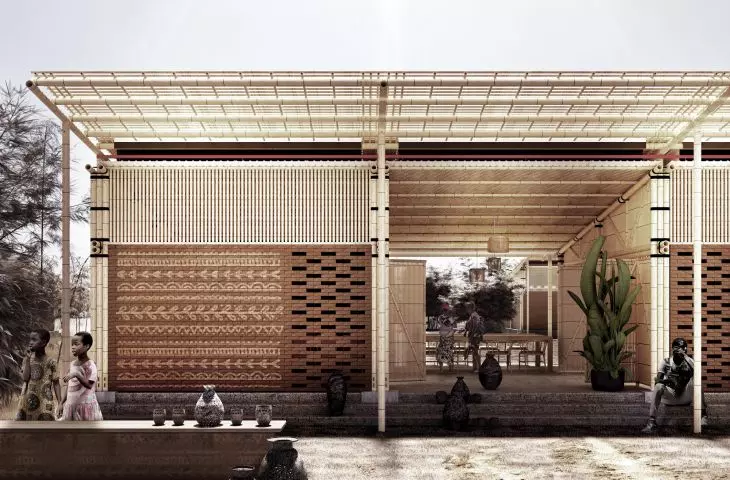Filip Zielinski of {tag:pracownie}, beating out 2,165 participants from 102 countries, won First Prize in the Crisis & Emergency category in the 10th edition of the Roca International Design Contest jumpthegap®. The "Redesign disaster" project is a special home module designed for African communities with difficult access to water. The Pole's design integrates a roof with a system for treating condensed water and rainwater using energy generated by solar panels.
The jumpthegap® competition organized by Roca in collaboration with the BcD-Barcelona Design Centre proposes a new look at the future. It is a future inspired by the cross-cutting challenges identified by the United Nations' 2030 Agenda for Sustainable Development, in the areas of healthcare and hygiene, protection of the planet, respect for diversity and equal access to technological innovations. In line with this vision, jumpthegap® participants presented technologically feasible projects that add value from the field of innovation and are characterized by diversity, sustainability, timelessness and adaptability. In order to take into account all these aspects of sustainability related to the bathroom space, the competition was divided into four categories: Wellness and Health, [Non]Neutral Design, Water and Energy, and Crisis and Emergencies. Three awards were given in each category, plus a special "Best of the Best" award for the best design.
"Redesign disaster" project, prototype visualization
© Filip Zielinski
As many as 2165 participants from 102 countries entered the competitions. All submitted projects were judged by a jury of renowned professionals led by Japanese architect and 2014 Pritzker Prize winner Shigeru Ban, as well as members: Somi Kim (director of Health Solutions at Johnson & Johnson (J&J) Design), Paul Priestman (designer, president of PriestmanGoode), Andrea Trimarchi and Simone Farresin (founders of design studio Formafantasma), Deborah Seward (director of the UN Regional Information Center inBelgium), Marian Amatullo (President of the Cumulus International Association of Universities and Colleges of Art, Design and Media), Isabela Roig (Executive Director of the BcD Barcelona Design Centre and World Design Weeks), and Marc Viardot (Director of Marketing and Projects of the Roca Group).
graphic showing water quality in Africa
© Filip Zielinski
First Prize for a Pole in the Crisis & Emergency category.
Among all the works, the jury awarded three designers from Poland. The third prize in the [Un]neutral design category went to Lukasz Paszkowski for "Mist brush." Second Prize in the Water & Energy category was won by Kamila Pawlak for "Design of a smart washbasin with water level indication." And the First Prize of €2,000 in the Crisis and Emergencies category went to Filip Zielinski of FAV.Office for his project "Redesign disaster.
Redesign disaster
The main premise of Filip Zielinski's project is to improve the living conditions of communities living in developing areas of East Africa by creating an independent, self-sufficient and, most importantly, affordable water purification system. These communities struggle with poor water quality, which is the cause of many diseases and deaths. The WHO estimates that more than one billion people worldwide have limited or no access to clean drinking water, and most of them come from rural areas where low population density makes it difficult to build typical water supply networks.
A graphic showing access to water in Mozambique
© Filip Zielinski
For example, many Mozambicans use unsanitary water. UNICEF reports that only half of the country's population has access to potable water. Life expectancy in Mozambique is 20 years shorter than in developed countries such as the U.S., due mainly to infectious diseases that spread through contaminated water.1 Achieving the goals set by UN member states in such a short period of time will not be easy. Providing clean water to rural communities without access to public sanitation is crucial. In this case, a system is needed that will effectively purify contaminated water, however, given the socio-economic situation of the region under consideration, it must be based on relatively simple technology and be as cheap as possible, says Filip Zielinski.
"Redesign disaster" project uses solar energy to purify water
© Filip Zielinski
Water purification through solar energy
In order to ensure the availability of clean water in the least urbanized areas, the architect designed a system that uses solar energy to purify any type of water entering the circulation. According to the author, commonly known, simple solar energy solutions are usually designed as small, single modules serving only individuals, and their efficiency is usually low. Using such modules to provide water for more people is uneconomical. In the "Redesign disaster" project, an improved solar distiller concept was adapted as part of the system, which purifies water used for all basic living needs on the roof of the facility.
Daily water consumption according to The Water Research Foundation
© Filip Zielinski
amount of water consumed per day
The Water Research Foundation of Cape Town in 2016 produced a guide for residents describing how to use 50 liters of water per day efficiently, so that there is enough to meet all human needs for life. In addition, the study says that by following additional recommendations on efficiency and gray water use, the amount of water needed can be reduced to 32 liters per day. In most African rural areas, people use an average of only 20 to 30 liters of water, and in the most isolated areas no more than 4 liters a day, which is only enough for drinking. 20 liters is the amount of water that flies through a typical shower faucet in 2 minutes. By comparison, people in Europe use between 100 and 200 liters of clean water per person per day.2 Water consumption is not only drinking, but also showering, cooking, flushing and other household needs, such as cleaning. The 20 square meters of the presented system, under the designed sunlight conditions, is capable of purifying 160 liters of water per day, which should be enough to meet the basic living needs of a typical local family of five, the author explains.
"Redesign disaster" project, 1:1 scale prototype
© Filip Zielinski
simple water purification system
The designed system mimics the natural process of evaporation and condensation, but it has been enclosed in a sealed environment. In the evaporation process, only water molecules float, so the evaporated water is clean, free of dangerous particles and metals and suitable for direct consumption.
The entire system consists of tanks, sand filters, several pumps and solar distillers. The technology is simple - instead of heating the entire water tank (as is done in typical solar distillers), the prototype concentrates solar energy only on the upper surface of the water, while the rest is thermally isolated with a polystyrene block.
Since only the top layer of water is heated, the evaporation process is faster and the use of solar energy is much more efficient. A 1:1 prototype of the system, measuring two square meters in size, was built and tested in Poland. The results of the tests carried out are promising and provide a strong foundation for further development of the project," says Filip Zielinski.
The author has also created a module that can function as a house, among other things.
© Filip Zielinski
object adapted to the local architecture
Keeping in mind the distinctive architecture of the East African region, the designer adapted the system to a facility that, in its form and scale, fits into the framework of local vernacular architecture. The modular design allows it to be used as a home for a multi-member family or, in a multi-module configuration, as public facilities such as public bathrooms, meeting places, stores or educational buildings.
The designed form of the roof allows it to be used most efficiently for clean water production in the system presented. In addition to its water purification function, the roof collects rainwater and shades the walls, significantly slowing down the heating of the interior. In addition, the roof was further raised above the top edge of the partition to improve the building's natural ventilation. Like the water treatment system, the building was designed using only locally available materials based on common construction techniques.
The project is in keeping with local vernacular architecture
© Filip Zielinski
The solution presented not only does not require the construction of additional infrastructure outside the facility, but has the potential for development and widespread use in the least urbanized areas - often inhabited by a significant portion of the region's population. The system can contribute to facilities with clean water, but most importantly - make the people using it feel safe. The possibility of basic hygiene, disinfection and consumption can be spread to all aspects of daily life. The system can be easily adapted in any region with similar solar radiation conditions. Developing and searching for new self-sustainable systems should be a common practice, as only they offer a real chance to achieve the set goals and thus rapidly improve the living conditions of all people living on the planet, Filip Zielinski concludes.
elaborated: Dobrawa Bies
1. by Roser, Esteban & Ritchie, 2019
2. European Commission, Statista, 2014/15, WHO, 2016



















































